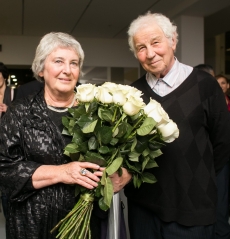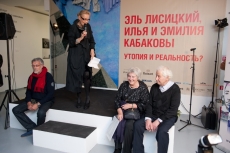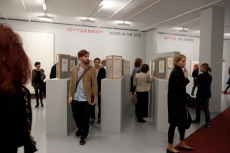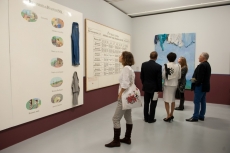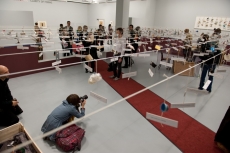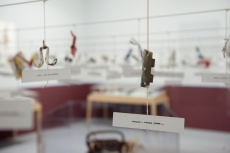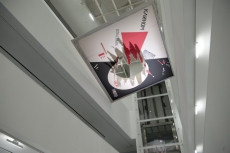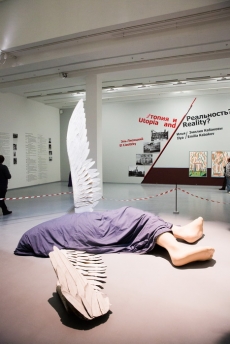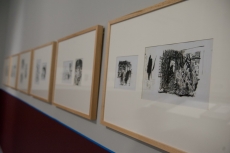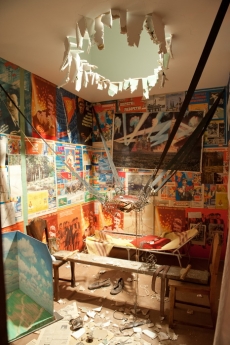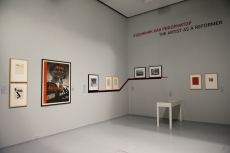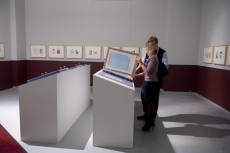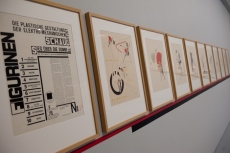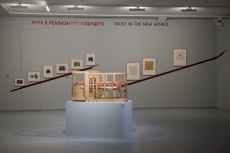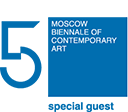Utopia and Reality? El Lissitzky, Ilya and Emilia Kabakov
Moscow, 17.09.2013—17.11.2013
exhibition is over
Share with friends
Curators: Charles Esche (Van Abbemuseum, Eindhoven), Olga Sviblova (Multimedia Art Museum, Moscow)
For the press
The exhibition «Utopia and Reality? El Lissitzky, Ilya and Emilia Kabakov» at Moscow’s Multimedia Art Museum is timed to coincide with Ilya Kabakov’s 80th birthday and organised by MAMM in collaboration with the Van Abbemuseum (Eindhoven) and the State Hermitage Museum (St. Petersburg).
El Lissitzky (1890-1941), one of the most important figures of the Russian avant-garde, was an artist, architect, book illustrator, photographer, exhibition designer and theoretician of the new art. The Van Abbemuseum houses the largest collection of El Lissitzky’s works outside Russia. That is why it initiated this joint exhibition of works by El Lissitzky and Ilya and Emilia Kabakov, developing the initial concept of the project in close cooperation with the Kabakovs. The exhibition in Moscow has been significantly expanded and, in particular, presents artworks by the Kabakovs that have never before been shown to wider audiences in Russia.
In many respects El Lissitzky, on the one hand, and Ilya and Emilia Kabakov, on the other, are opposites in terms of the artists’ aesthetic and ideological principles.
El Lissitzky entered the history of Russian and world culture as the developer of a new plastic language compliant with the post-revolutionary Russian ambitions to reconstruct human life, and with the utopian aspirations of that time in a broader context. In our perception his name is directly linked to the early stage of the Soviet utopian project, to the idea of a «new language for the new people», an idea of design as the instrument with which all mankind could be transformed.
But in the words of Ilya Kabakov, «in any creative concept there are three components: the plan, the attempt at its realisation and the finished product. It should be said that the person involved at the beginning, the planner, has no idea what will happen midway through the process, or how it will end.»
The passage of time has revealed that Lissitzky’s Prouns corresponded aesthetically to the tendencies of world modernism and actually became an absolute model, a fundamental basis for an international language of design. But can we say that Lissitzky, who from the very beginning worked in the material world, creating «imaginary space by means of material objects,» was an artist of utopian aspirations? And most importantly, can the initial characteristics be preserved in a realised utopia?
One can say that the Kabakovs lived in the realised Soviet utopia that was propagandised by Lissitzky, among others. The Communist project began to turn into its antithesis even during Lissitzky’s lifetime, when the authoritarian, anti-humanitarian element of the avant-garde project to invent a new man-creator became increasingly evident.
Back then Lissitzky wrote with enthusiasm: «Our generation has set itself the aim of working precisely in accordance with commission. But practice has shown that the work of true artistic worth can be created only when the artist sets out his own objective (the eternal social commission)». But Lissitzky himself, according to Kabakov, managed to participate «in the middle movement of the symphony, when he seemed like a small screw in the machine, as a specialist implementing the will of the Party and its leader.»
The Kabakovs belong to the generation of artists who lived and worked in, «as it seemed then, time that had stopped forever, and there existed a thoroughly (as it turned out, terminally) crafted Soviet language of official Soviet art.» They became witnesses of the humanitarian catastrophe that the radiant utopian project became during the attempt at its implementation. Accordingly, these artists have an entirely different vision, a different attitude both to the Soviet utopia in principle and to the ideology of the Russian avant-garde, which they can assess from a historical distance. The exhibition develops as a system of oppositions, as a direct spatial comparison between the works of Lissitzky and Ilya and Emilia Kabakov: «The Cosmos — Voices in the Void,» «Clarity of Forms — Garbage,» «Victory over the Everyday — Everyday’s Victory,» «Monument to a Leader — Monument to a Tyrant,» «Transforming Life — Escaping Life,» «Trust in the New World — Unrealized Utopia,» «The Artist as a Reformer — The Artist as a Reflecting Character.»
This exhibition is particularly apt today when we strive yet again to find some kind of utopian project modality. The global crisis that the world faced at the beginning of the 20th century made us return to the search for a new utopia. The exhibition «Utopia and Reality?» is devoted to humanity’s craving for utopian projects and the tragic results to which attempting to implement them usually leads.
We would like to express deep gratitude to all the institutions and collectors that have lent artworks for the exhibition: Van Abbemuseum, Musée National d’Art Moderne / Centre Georges Pompidou, Solomon R. Guggenheim Museum, State Hermitage Museum, State Tretyakov Gallery, A.A. Bakhrushin State Central Theatre Museum, Russian State Archive of Literature and Art, Harmony Trust Settlement, Tsukanov Family Foundation, Galleria Continua, Galerie Thaddaeus Ropac, Regina Gallery, Erna Jolles, Hein van Laarhoven, Sergey Lissitzky and Vladimir Tsarenkov.

